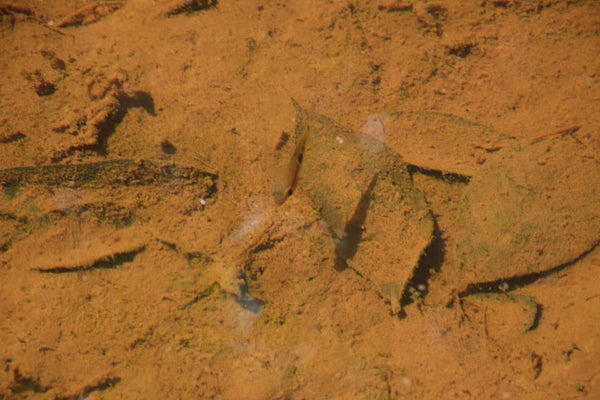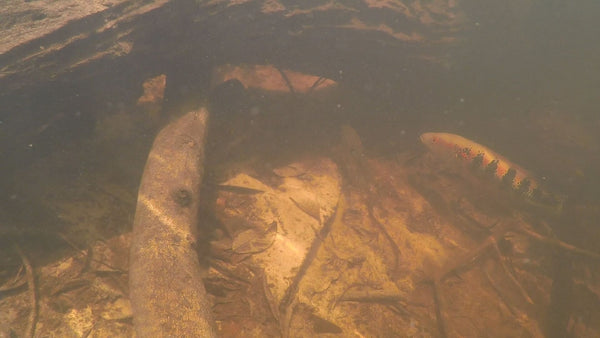- Continue Shopping
- Your Cart is Empty
Substrate confidential...Another look at the "stuff on the bottom..."
If you're a regular consumer of our content, you know of my obsession with varying substrate compositions and what I call "enhancement" of the substrate- you know, adding mixes of various materials to create different aesthetics and function.

You've likely seen my recent work with with different materials, like leaves, botanicals, clays, and sediments that I've shared with you here and elsewhere. It's an idea that I just can't get away from! In fact, it's something I'm borderline obsessed with!

Studies have shown that particle sizes tend to decrease the further downstream from the source they are found. Large rivers, such as the Amazon, have beds of shifting sands, slowly transported with the currents. Typically, the larger the item (pebble, rock, or boulder, the longer it tends to stay in one place. So, in a more powerful flow, you're more likely to find larger-sized materials.

The first recorded observations of bed material of the Amazon River were made in 1843 by Lt William Lewis Herndon of the US Navy, when he travelled the river from its headwaters to its mouth, sounding its depths, and noting the nature of particles caught in a heavy grease smeared to the bottom of his sounding weight.
He reported the bed material of the river to be mostly sand and fine gravel. Oltman and Ames took samples at a few locations in 1963 and 1964, and reported the bed material at Óbidos, Brazil, to be fine sands, with median diameters ranging from 0.15 to 0.25 mm.

There is a LOT to the science of naturally "graded" materials, and you'll have to do some research on the subject. In the end, science can tell you a lot; however, creativity and your aesthetic taste are typically the "guidelines" that you'll embrace to assemble your "slice of the bottom."

However, the physical composition of the substrate materials is but one aspect of these interesting aquatic systems...
The other, and perhaps equally fascinating part of the equation is the story of how the materials reach these streams and are distributed there. Yeah- no pice on the substrate composition of these habitats would be complete without a quick review of the streams themselves and how they arise and function within the broader ecology of a region.

Stream and river bottom composition is affected by a wide range of things, like regional weather, current, geology, the surrounding dry lands, and a host of other factors- all of which could make planning your next aquarium even more interesting if you take them into consideration!
If we focus on streams, it's important to note that the volume of water entering the stream, and the depth of the channels it carves out, helps in part determine the amount and size of sediment particles that can be carried along, and thus comprise the substrate.

And of course, the composition of bottom materials and the depth of the channel are always changing in response to the flow in a given stream, affecting the composition and ecology in many ways. Lighter materials, such as leaves, sediments, and twigs, will of course be redistributed by current and other factors. And of course, leaf litter beds, as we've discussed numerous times here, are one of the underwater world's most productive habitats- host to numerous life forms, ranging from fishes to fungi.

Some leaf litter beds form in what stream ecologists call "meanders", which are stream structures that form when moving water in a stream erodes the outer banks and widens its "valley", and the inner part of the river has less energy and deposits silt- or in our instance, leaves.

There is a whole, fascinating science to river and stream structure, and with so many implications for understanding how these structures and mechanisms affect fish population, occurrence, behavior, and ecology, it's well worth studying for aquarium interpretation! Did you get that part where I mentioned that the lower-energy parts of the water courses tend to accumulate leaves and sediments and stuff?
Likely you did! I mean, I'm pretty certain that you did!

The lower-energy parts of streams are often where the greater population of fishes and food items are found; and, they happen to be relatively simple to replicate in the confines of the aquarium. And the coolest part about this is that you can derive many of the same benefits from these litter beds in the aquarium as are found in Nature!

Permanent streams will often have different volume and material composition (usually finely-packed sands and gravels, with lots of smooth stones) than more intermittent streams, which are the result of inundation caused by rain, etc.

So-called "ephemeral" streams, typically occur only immediately after rain events (which means they usually don't have fish in them unless they are washed into them from more permanent watercourses). This is, of course, just another example of how weather and seasonal events affect not only the composition- but the very formation- of streams.

The latter two stream types are typically more affected by leaves, botanical debris, branches, and other materials. The substrates are typically littered with these materials, which are constantly being redistributed as water flows into and out of them.

In the Amazon region (you knew I was sort of headed back that way, right?), it sort of works both ways, with the rivers influencing the surrounding land...and then the land "giving" some of the materials back to the rivers...the extensive lowland areas bordering the river and its tributaries, known as varzeas (“floodplains”), are subject to annual flooding, which helps foster enrichment of the aquatic environment.

Although many streams derive their food base from leaves and organic matter, there is a lot of other material present that contributes to its structure. Think along those lines when scheming your next aquarium. Ask yourself what factors would contribute to the bottom composition of the area you're taking inspiration from.

You'll see a variety of bottom compositions in Amazonian and other streams, ranging from the aforementioned leaves and detritus in stream margins, to sand and silt over "cobbles", to boulders covered in algae, to fine patch gravels, root tangles, and even just silt.

You might even say that rivers and streams act like nature's "sediment sorting machines", as they move debris, geologic materials, and botanicals along their courses. And along the way, varying ecological communities are assembled, with all sorts of different fishes being attracted to different niches.

Interestingly, in most streams, the primary producers of the food webs that attract our fishes are algae and diatoms, which are typically found on rocks and wood wherever light and nutrients create optimum conditions for their growth. Organic material that enters streams via leaf fall is acted upon by small organisms, which help break it down.
It is probably no surprise, then, that bacteria (especially in biofilms!) and fungi are the initial consumers of the organic materials that accumulate on the bottom. Like, the stuff many of us loathe. These, in turn, are extremely vital to fishes as a food source. Hence, one of the things I love so much about utilizing a leaf litter bed as a big part of your substrate composition in an aquarium!

Streams which flow over stony, open bottoms, free from natural obstacles like tree trunks and such, tend to develop a rich algal turf on their surfaces.

While not something a lot of hobbyists like to see in their tanks (with the exception of Mbuna guys, some shrimp keepers, and a few true weirdos like me), algae-covered stones and rocks are entirely natural and appropriate for the bottom of many aquariums! Enter a tank with THAT in the next snobby, pretentious international "natural" aquascaping contest and watch the ensuing judge "freak-out" it causes! Oh, hell YES!!!
Grazing fishes, of course, will feed on and among these algal films, and would be logical choices for a stony-bottom-themed aquarium. When we think about the way natural fish communities are assembled in rivers and streams, it's almost always as a result of adaptations to the physical environment and food sources.

Now, not everyone wants to have algae-covered stones or a mass of decomposing leaves on the bottom of their aquarium. However, I think that considering the role that these materials play in the composition of streams and the lives of the fishes which inhabit them is important, and entirely consistent with our goal of creating the most natural, effective aquariums for the animals which we keep.
So, we've barely scratched the surface of the very bottom...However, I hope that I've helped click on the lightbulb in your head to consider that what goes on "down there" is every bit as important as any other part of the aquarium! There is plenty of scholarly research out there to draw on for inspiration and information to help you divise a plan.
Let's pay a little more attention to the "stuff on the bottom" in both our tanks and in Nature...because there's so much cool stuff to learn!
Stay curious. Stay creative. Stay excited. Stay inspired...
And Stay Wet.
Scott Fellman
Tannin Aquatics






Scott Fellman
Author